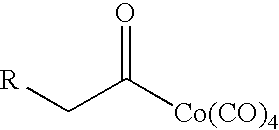Metal-catalyzed copolymerization of imines and carbon monoxide as a route to synthesize polypeptides
a technology of imine and carbon monoxide, which is applied in the field of new method for synthesis of polypeptides, can solve problems such as difficulties in realization
- Summary
- Abstract
- Description
- Claims
- Application Information
AI Technical Summary
Benefits of technology
Problems solved by technology
Method used
Image
Examples
example 1
[0064]
[0065]To a 300 mL autoclave of stainless steel were added 50 mL dry dioxane and 3 mL (6 mmol) of the 2.0 M solution of the acylcobalt catalyst (III: R3=PhCH2, L=CO) in hexane in an atmosphere of carbon monoxide. After closing the valve, the pressure of carbon monoxide was raised to 5.52 MPa, and the autoclave was allowed to stand at room temperature for 12 hours. After releasing pressure, 1.0 g (66 mol) of imine IIa was added to the autoclave. After closing the valve, the pressure of carbon monoxide was increased to 5.52 MPa once again. The mixture in the autoclave was heated in an oil-both at 50° C. while magnetically stirred for 12 hours. After cooling to room temperature, the pressure was released and the reactor was opened. The resulting solution was a brownish black liquid. The solvent was removed under vacuum to afford a brownish black glutinous material. A small amount of n-hexane was added to the brownish black glutinous material, and sufficient agitation and washing w...
example 2
[0066]Example 1 was repeated using 3 mmol of acylcobalt catalyst (III). Polypeptide Ia was obtained as an off-white powdery solid.
example 3
[0067]Example 1 was repeated using hexane as the diluent. A crude product of polypeptide Ia was obtained as an off-white powdery solid.
PUM
| Property | Measurement | Unit |
|---|---|---|
| pressure | aaaaa | aaaaa |
| reaction temperature | aaaaa | aaaaa |
| pressure | aaaaa | aaaaa |
Abstract
Description
Claims
Application Information
 Login to View More
Login to View More - R&D
- Intellectual Property
- Life Sciences
- Materials
- Tech Scout
- Unparalleled Data Quality
- Higher Quality Content
- 60% Fewer Hallucinations
Browse by: Latest US Patents, China's latest patents, Technical Efficacy Thesaurus, Application Domain, Technology Topic, Popular Technical Reports.
© 2025 PatSnap. All rights reserved.Legal|Privacy policy|Modern Slavery Act Transparency Statement|Sitemap|About US| Contact US: help@patsnap.com



